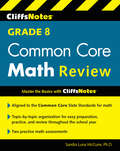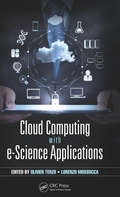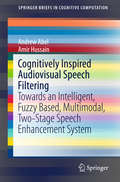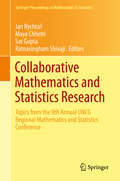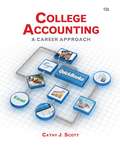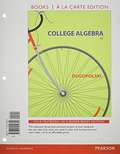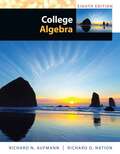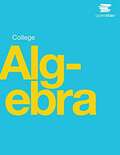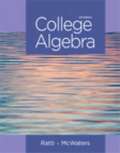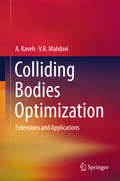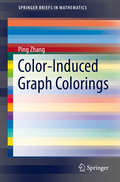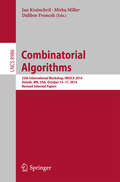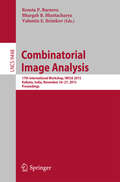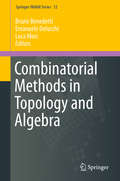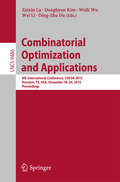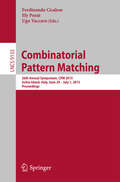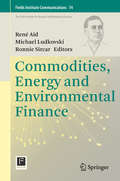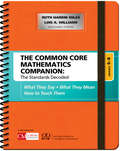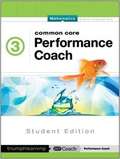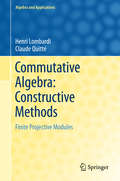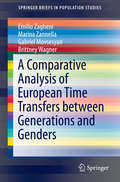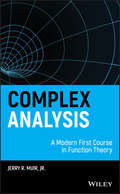- Table View
- List View
CliffsNotes Grade 6 Common Core Math Review
by Sandra Luna MccuneNearly half of adults, including parents of middle-school students, have never heard of the Common Core State Standards, let alone have a working knowledge of what exactly their children face when it comes to middle-school math. Even teachers acknowledge struggling with how best to teach their students these math standards.CliffsNotes comes to the rescue with this Grade 6 Common Core Math Review. Aligned to the state standards, this book provides essential coverage of the Grade 6 CCSS math that's challenging middle-school students, teachers, and parents alike.The material covers all of the math standards that comprise Grade 6 CCSS math: * Ratios and proportional relationships * The number system * Geometry * Expressions and equations * Statistics and probabilityTwo practice tests round out the book, plus every review chapter includes example problems.
Cloud Computing with e-Science Applications
by Olivier Terzo Lorenzo MossuccaThe amount of data in everyday life has been exploding. This data increase has been especially significant in scientific fields, where substantial amounts of data must be captured, communicated, aggregated, stored, and analyzed. Cloud Computing with e-Science Applications explains how cloud computing can improve data management in data-heavy fields such as bioinformatics, earth science, and computer science. The book begins with an overview of cloud models supplied by the National Institute of Standards and Technology (NIST), and then: Discusses the challenges imposed by big data on scientific data infrastructures, including security and trust issues Covers vulnerabilities such as data theft or loss, privacy concerns, infected applications, threats in virtualization, and cross-virtual machine attack Describes the implementation of workflows in clouds, proposing an architecture composed of two layers—platform and application Details infrastructure-as-a-service (IaaS), platform-as-a-service (PaaS), and software-as-a-service (SaaS) solutions based on public, private, and hybrid cloud computing models Demonstrates how cloud computing aids in resource control, vertical and horizontal scalability, interoperability, and adaptive scheduling Featuring significant contributions from research centers, universities, and industries worldwide, Cloud Computing with e-Science Applications presents innovative cloud migration methodologies applicable to a variety of fields where large data sets are produced. The book provides the scientific community with an essential reference for moving applications to the cloud.
Cognitively Inspired Audiovisual Speech Filtering: Towards an Intelligent, Fuzzy Based, Multimodal, Two-Stage Speech Enhancement System (SpringerBriefs in Cognitive Computation #5)
by Amir Hussain Andrew AbelThis book presents a summary of the cognitively inspired basis behind multimodal speech enhancement, covering the relationship between audio and visual modalities in speech, as well as recent research into audiovisual speech correlation. A number of audiovisual speech filtering approaches that make use of this relationship are also discussed. A novel multimodal speech enhancement system, making use of both visual and audio information to filter speech, is presented, and this book explores the extension of this system with the use of fuzzy logic to demonstrate an initial implementation of an autonomous, adaptive, and context aware multimodal system. This work also discusses the challenges presented with regard to testing such a system, the limitations with many current audiovisual speech corpora, and discusses a suitable approach towards development of a corpus designed to test this novel, cognitively inspired, speech filtering system.
Collaborative Mathematics and Statistics Research: Topics from the 9th Annual UNCG Regional Mathematics and Statistics Conference (Springer Proceedings in Mathematics & Statistics #109)
by Jan Rychtář Sat Gupta Ratnasingham Shivaji Maya ChhetriThis volume contains rigorously reviewed papers on the topics presented by students at The 9th Annual University of North Carolina at Greensboro Regional Mathematics and Statistics Conference (UNCG RMSC) that took place on November 2, 2013. All papers are coauthored by student researchers and their faculty mentors. This conference series was inaugurated in 2005, and it now attracts over 150 participants from over 30 universities from North Carolina and surrounding states. The conference is specifically tailored for students to present their research projects that encompass a broad spectrum of topics in mathematics, mathematical biology, statistics, and computer science.
College Accounting: A Career Approach (12th Edition)
by Cathy J. ScottThe twelfth edition of COLLEGE ACCOUNTING: A CAREER APPROACH maintains its dedicated emphasis on the significance of the College Accounting course as true groundwork for students' future classes and jobs, and a greater focus on teaching the fundamentals of accounting from a career development approach. This text builds student skills in the areas of accounting knowledge, technology, communication, ethics, and critical thinking, providing students the skills needed to be successful in life and work. With a focus on small business, COLLEGE ACCOUNTING: A CAREER APPROACH, Twelfth Edition, provides real-world context that keeps chapter content relevant and vital.
College Algebra
by Mark DugopolskiWith an emphasis on problem solving and critical thinking, Mark Dugopolski's College Algebra, Sixth Edition gives students the essential strategies to help them develop the comprehension and confidence they need to be successful in this course. Students will find carefully placed learning aids and review tools to help them do the math.
College Algebra
by Richard N. Aufmann Richard D. NationAccessible to students and flexible for instructors, COLLEGE ALGEBRA, EIGHTH EDITION, incorporates the dynamic link between concepts and applications to bring mathematics to life. By integrating interactive learning techniques, the Aufmann author team helps students to better understand concepts, work independently, and obtain greater mathematical fluency. The Eighth Edition also includes technology features to accommodate courses that allow the option of using graphing calculators. Additional program components that support student success include tutorial practice, online homework, Live Online Tutoring, and Instructional DVDs. The authors' proven Aufmann Interactive Method allows students to try a skill as it is presented in example form. This interaction between the examples and Try Exercises serves as a checkpoint to students as they read the textbook, do their homework, or study a section. In the Eighth Edition, Review Notes are featured more prominently throughout the text to help students recognize the key prerequisite skills needed to understand new concepts.
College Algebra
by Jay Abramson OpenStaxCollege Algebra provides a comprehensive exploration of algebraic principles and meets scope and sequence requirements for a typical introductory algebra course. The modular approach and richness of content ensure that the book meets the needs of a variety of courses. College Algebra offers a wealth of examples with detailed, conceptual explanations, building a strong foundation in the material before asking students to apply what they’ve learned.
College Algebra (Third Edition)
by J. S. Ratti Marcus S. McwatersRatti and McWaters have combined years of lecture notes and classroom experience to bring you a series that connects concepts and maintains course rigor. An extensive array of exercises and learning aids further complements your instruction, which ultimately helps to improve student mathematical understanding and results in the course.
Colliding Bodies Optimization: Extensions and Applications
by A. Kaveh V. R. MahdaviThis book presents and applies a novel efficient meta-heuristic optimization algorithm called Colliding Bodies Optimization (CBO) for various optimization problems. The first part of the book introduces the concepts and methods involved, while the second is devoted to the applications. Though optimal design of structures is the main topic, two chapters on optimal analysis and applications in constructional management are also included. This algorithm is based on one-dimensional collisions between bodies, with each agent solution being considered as an object or body with mass. After a collision of two moving bodies with specified masses and velocities, these bodies again separate, with new velocities. This collision causes the agents to move toward better positions in the search space. The main algorithm (CBO) is internally parameter independent, setting it apart from previously developed meta-heuristics. This algorithm is enhanced (ECBO) for more efficient applications in the optimal design of structures. The algorithms are implemented in standard computer programming languages (MATLAB and C++) and two main codes are provided for ease of use.
Color-Induced Graph Colorings: Vertex And Neighbor Distinguishing Edge Colorings Of Graphs (SpringerBriefs in Mathematics)
by Ping ZhangA comprehensive treatment of color-induced graph colorings is presented in this book, emphasizing vertex colorings induced by edge colorings. The coloring concepts described in this book depend not only on the property required of the initial edge coloring and the kind of objects serving as colors, but also on the property demanded of the vertex coloring produced. For each edge coloring introduced, background for the concept is provided, followed by a presentation of results and open questions dealing with this topic. While the edge colorings discussed can be either proper or unrestricted, the resulting vertex colorings are either proper colorings or rainbow colorings. This gives rise to a discussion of irregular colorings, strong colorings, modular colorings, edge-graceful colorings, twin edge colorings and binomial colorings. Since many of the concepts described in this book are relatively recent, the audience for this book is primarily mathematicians interested in learning some new areas of graph colorings as well as researchers and graduate students in the mathematics community, especially the graph theory community.
Combinatorial Algorithms: 25th International Workshop, IWOCA 2014, Duluth, MN, USA, October 15-17, 2014, Revised Selected Papers (Lecture Notes in Computer Science #8986)
by Jan Kratochvíl Mirka Miller Dalibor FroncekThis book constitutes the thoroughly refereed post-workshop proceedings of the 25th International Workshop on Combinatorial Algorithms, IWOCA 2014, held in Duluth, MN, USA, in October 2014. The 32 revised full papers presented were carefully reviewed and selected from a total of 69 submissions. The papers focus on topics such as Algorithms and Data Structures, Combinatorial Enumeration, Combinatorial Optimization, Complexity Theory (Structural and Computational), Computational Biology, Databases (Security, Compression and Information Retrieval), Decompositions and Combinatorial Designs, Discrete and Computational Geometry, as well as Graph Drawing and Graph Theory. IWOCA is a yearly forum for researchers in designing algorithms field to advance creativeness of intersection between mathematics and computer science. This is the first time this conference is being held in U. S.
Combinatorial Image Analysis: 17th International Workshop, IWCIA 2015, Kolkata, India, November 24-27, 2015. Proceedings (Lecture Notes in Computer Science #9448)
by Reneta P. Barneva Bhargab B. Bhattacharya Valentin E. BrimkovThis volume constitutes the refereed proceedings of the17th International Workshop on Combinatorial Image Analysis, IWCIA 2015, heldin Kolkata, India, in November 2015. The 24 revised full papers and 2 invited papers presentedwere carefully reviewed and selected from numerous submissions. The workshopprovides theoretical foundations and methods for solving problems from variousareas of human practice. In contrast to traditional approaches to imageanalysis which implement continuous models, float arithmetic and rounding,combinatorial image analysis features discrete modelsusing integer arithmetic. The developed algorithms are based on studying combinatorial properties ofclasses of digital images, and often appear to be more efficient and accuratethan those based on continuous models.
Combinatorial Methods in Topology and Algebra (Springer INdAM Series #12)
by Bruno Benedetti Emanuele Delucchi Luca MociCombinatorics plays a prominent role in contemporary mathematics, due to the vibrant development it has experienced in the last two decades and its many interactions with other subjects. This book arises from the INdAM conference "CoMeTA 2013 - Combinatorial Methods in Topology and Algebra,'' which was held in Cortona in September 2013. The event brought together emerging and leading researchers at the crossroads of Combinatorics, Topology and Algebra, with a particular focus on new trends in subjects such as: hyperplane arrangements; discrete geometry and combinatorial topology; polytope theory and triangulations of manifolds; combinatorial algebraic geometry and commutative algebra; algebraic combinatorics; and combinatorial representation theory. The book is divided into two parts. The first expands on the topics discussed at the conference by providing additional background and explanations, while the second presents original contributions on new trends in the topics addressed by the conference.
Combinatorial Optimization and Applications: 9th International Conference, COCOA 2015, Houston, TX, USA, December 18-20, 2015, Proceedings (Lecture Notes in Computer Science #9486)
by Ding-Zhu Du Wei Li Weili Wu Zaixin Lu Donghyun KimThis book constitutes the refereed proceedings of the 9th International Conference on Combinatorial Optimization and Applications, COCOA 2015, held in Houston, TX, USA, in December 2015. The 59 full papers included in the book were carefully reviewed and selected from 125 submissions. Topics covered include classic combinatorial optimization; geometric optimization; network optimization; applied optimization; complexity and game; and optimization in graphs.
Combinatorial Pattern Matching: 26th Annual Symposium, CPM 2015, Ischia Island, Italy, June 29 -- July 1, 2015, Proceedings (Lecture Notes in Computer Science #9133)
by Ferdinando Cicalese Ely Porat Ugo VaccaroThis book constitutes the refereed proceedings of the 26th Annual Symposium on Combinatorial Pattern Matching, CPM 2015, held on Ischia Island, Italy, in June/July 2015. The 34 revised full papers presented together with 3 invited talks were carefully reviewed and selected from 83 submissions. The papers address issues of searching and matching strings and more complicated patterns such as trees; regular expressions; graphs; point sets; and arrays. The goal is to derive combinatorial properties of such structures and to exploit these properties in order to achieve superior performance for the corresponding computational problems. The meeting also deals with problems in computational biology; data compression and data mining; coding; information retrieval; natural language processing; and pattern recognition.
Commodities, Energy and Environmental Finance (Fields Institute Communications #74)
by René Aïd Ronnie Sircar Michael LudkovskiThis volume is a collection of chapters covering the latest developments in applications of financial mathematics and statistics to topics in energy, commodity financial markets and environmental economics. The research presented is based on the presentations and discussions that took place during the Fields Institute Focus Program on Commodities, Energy and Environmental Finance in August 2013. The authors include applied mathematicians, economists and industry practitioners, providing for a multi-disciplinary spectrum of perspectives on the subject. The volume consists of four sections: Electricity Markets; Real Options; Trading in Commodity Markets; and Oligopolistic Models for Energy Production. Taken together, the chapters give a comprehensive summary of the current state of the art in quantitative analysis of commodities and energy finance. The topics covered include structural models of electricity markets, financialization of commodities, valuation of commodity real options, game-theory analysis of exhaustible resource management and analysis of commodity ETFs. The volume also includes two survey articles that provide a source for new researchers interested in getting into these topics.
Common Core Algebra I
by Kirk Weiler Garrett MatulaThis workbook contains over 100 lessons and homework sets that cover the PARCC End of Year Standards from the Common Core Curriculum. <p><p> Unit 1 – The Building Blocks of Algebra <p>Unit 2 – Linear Expressions, Equations, and Inequalities <p>Unit 3 – Functions <p>Unit 4 – Linear Functions and Arithmetic Sequences <p>Unit 5 – Systems of Linear Equations and Inequalities <p>Unit 6 – Exponents, Exponents, Exponents and More Exponents <p>Unit 7 – Polynomials <p>Unit 8 – Quadratic Functions and Their Algebra <p>Unit 9 – Roots and Irrational Numbers <p>Unit 10 – Statistics <p>Unit 11 – A Final Look at Functions and Modeling
The Common Core Mathematics Companion: What They Say, What They Mean, How to Teach Them (Corwin Mathematics Ser.)
by Ruth Harbin Miles Lois A. Williams"The Common Core Mathematics Companion 6-8 offers a practical guide for implementing the CCSS Math Standards. Teachers will appreciate the misconception alerts and ideas for differentiation." — Jay McTighe, Author and Consultant When it comes to math, standards-aligned is achievement-aligned… In the short time since The Common Core Mathematics Companions, Grades K-2 and 3-5 burst on the scene, they have been lauded as the best resources for making critical math ideas easy to teach. With this brand-new 6-8 volume, middle school math success is at your fingertips. Page by page, the authors lay out the pieces to a cutting-edge curriculum, helping you to: Get the inside scoop on which standards connect, what key vocabulary means, and time-saving tables showing where to focus instruction for each grade Write curriculum for: ratios and proportional relationships, the number system, expressions and equations, functions, geometry, and statistics & probability Use the What to Teach pages to deliver powerful standards-based lessons Learn effective techniques to create an environment where all students can experience math break-throughs Incorporate the Standards for Mathematical Practice to improve students’ ability to problem solve, construct viable arguments, use tools strategically, attend to precision, and more The Common Core Mathematics Companion, Grades 6–8 has what every middle school needs to provide students with the foundation for the concepts and skills they will be expected to know in grade 9–12. Ruth Harbin Miles is a mathematics coach, with special expertise in developing teachers’ content knowledge and strategies for engaging students to achieve high mathematics standards. A serving member on the Board of Directors for the National Council of Teachers of Mathematics and the National Council of Supervisors of Mathematics, Ruth is a co-author with Linda Gojak of The Common Core Mathematics Companions, K–2 and 3–5 (Corwin). Lois Williams, Ed.D., who taught mathematics in grades K–8 for 20 years, is currently an adjunct professor at Mary Baldwin College and an International Fellow with the Charles A. Dana Center, training teachers in the College and Career Readiness Standards She has been honored with a Fulbright Teacher Exchange and the Virginia Middle School Mathematics Teacher of the Year award.
The Common Core Mathematics Companion: What They Say, What They Mean, How to Teach Them (Corwin Mathematics Ser.)
by Ruth Harbin Miles Lois A. Williams"The Common Core Mathematics Companion 6-8 offers a practical guide for implementing the CCSS Math Standards. Teachers will appreciate the misconception alerts and ideas for differentiation." — Jay McTighe, Author and Consultant When it comes to math, standards-aligned is achievement-aligned… In the short time since The Common Core Mathematics Companions, Grades K-2 and 3-5 burst on the scene, they have been lauded as the best resources for making critical math ideas easy to teach. With this brand-new 6-8 volume, middle school math success is at your fingertips. Page by page, the authors lay out the pieces to a cutting-edge curriculum, helping you to: Get the inside scoop on which standards connect, what key vocabulary means, and time-saving tables showing where to focus instruction for each grade Write curriculum for: ratios and proportional relationships, the number system, expressions and equations, functions, geometry, and statistics & probability Use the What to Teach pages to deliver powerful standards-based lessons Learn effective techniques to create an environment where all students can experience math break-throughs Incorporate the Standards for Mathematical Practice to improve students’ ability to problem solve, construct viable arguments, use tools strategically, attend to precision, and more The Common Core Mathematics Companion, Grades 6–8 has what every middle school needs to provide students with the foundation for the concepts and skills they will be expected to know in grade 9–12. Ruth Harbin Miles is a mathematics coach, with special expertise in developing teachers’ content knowledge and strategies for engaging students to achieve high mathematics standards. A serving member on the Board of Directors for the National Council of Teachers of Mathematics and the National Council of Supervisors of Mathematics, Ruth is a co-author with Linda Gojak of The Common Core Mathematics Companions, K–2 and 3–5 (Corwin). Lois Williams, Ed.D., who taught mathematics in grades K–8 for 20 years, is currently an adjunct professor at Mary Baldwin College and an International Fellow with the Charles A. Dana Center, training teachers in the College and Career Readiness Standards She has been honored with a Fulbright Teacher Exchange and the Virginia Middle School Mathematics Teacher of the Year award.
Common Core Performance Coach Grade 3 Mathematics
by Triumph Learning LlcKey concepts and skills are reintroduced that are a prerequisite to mastering grade-level content.
Commutative Algebra: Finite Projective Modules (Algebra and Applications #20)
by Henri Lombardi Claude QuittéTranslated from the popular French edition, this book offers a detailed introduction to various basic concepts, methods, principles, and results of commutative algebra. It takes a constructive viewpoint in commutative algebra and studies algorithmic approaches alongside several abstract classical theories. Indeed, it revisits these traditional topics with a new and simplifying manner, making the subject both accessible and innovative. The algorithmic aspects of such naturally abstract topics as Galois theory, Dedekind rings, Prüfer rings, finitely generated projective modules, dimension theory of commutative rings, and others in the current treatise, are all analysed in the spirit of the great developers of constructive algebra in the nineteenth century. This updated and revised edition contains over 350 well-arranged exercises, together with their helpful hints for solution. A basic knowledge of linear algebra, group theory, elementary number theory as well as the fundamentals of ring and module theory is required. Commutative Algebra: Constructive Methods will be useful for graduate students, and also researchers, instructors and theoretical computer scientists.
A Comparative Analysis of European Time Transfers between Generations and Genders (SpringerBriefs in Population Studies)
by Emilio Zagheni Marina Zannella Gabriel Movsesyan Brittney WagnerThis comparative study of European time transfers reveals the full extent of transfers in the form of unpaid work and highlights the existence of important gender differences in household time production. A large quantity of goods and services are produced by household members for their own consumption, without involving market transactions. Despite the economic and social importance of unpaid work, these productive activities are largely invisible to traditional national economic accounts. As a consequence, standard measures of intergenerational transfers typically ignore household production, and thus underestimate the overall value of goods and services produced over the life cycle; in particular, the economic contribution of females. The book uses a life course approach to offer policy-relevant insights into the effect of demographic and social change on intergenerational ties and gender inequality in household production.
Complex Analysis
by Jerry R. MuirA thorough introduction to the theory of complex functions emphasizing the beauty, power, and counterintuitive nature of the subject Written with a reader-friendly approach, Complex Analysis: A Modern First Course in Function Theory features a self-contained, concise development of the fundamental principles of complex analysis. After laying groundwork on complex numbers and the calculus and geometric mapping properties of functions of a complex variable, the author uses power series as a unifying theme to define and study the many rich and occasionally surprising properties of analytic functions, including the Cauchy theory and residue theorem. The book concludes with a treatment of harmonic functions and an epilogue on the Riemann mapping theorem. Thoroughly classroom tested at multiple universities, Complex Analysis: A Modern First Course in Function Theory features: Plentiful exercises, both computational and theoretical, of varying levels of difficulty, including several that could be used for student projects Numerous figures to illustrate geometric concepts and constructions used in proofs Remarks at the conclusion of each section that place the main concepts in context, compare and contrast results with the calculus of real functions, and provide historical notes Appendices on the basics of sets and functions and a handful of useful results from advanced calculus Appropriate for students majoring in pure or applied mathematics as well as physics or engineering, Complex Analysis: A Modern First Course in Function Theory is an ideal textbook for a one-semester course in complex analysis for those with a strong foundation in multivariable calculus. The logically complete book also serves as a key reference for mathematicians, physicists, and engineers and is an excellent source for anyone interested in independently learning or reviewing the beautiful subject of complex analysis.
